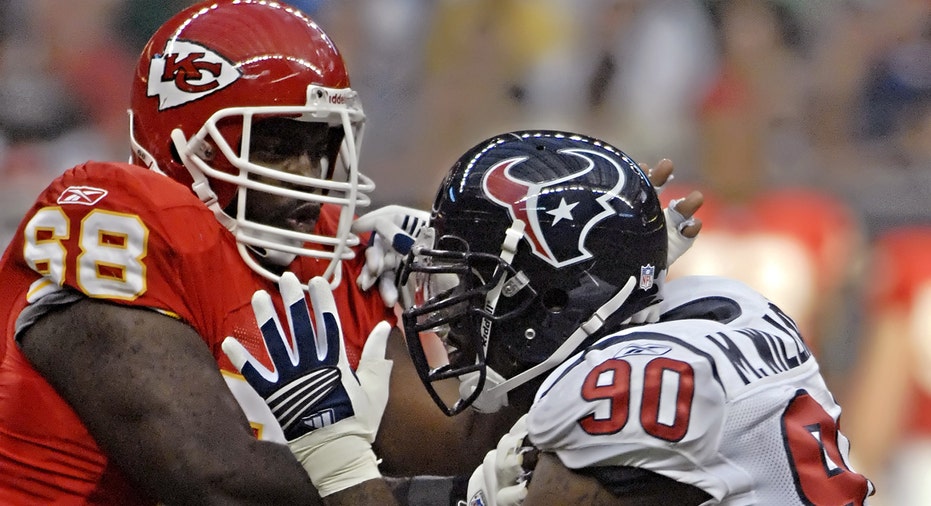NFL Legend Will Shields: 'I Still Would Play' Despite Concussion Risks

Hall of Fame offensive lineman Will Shields remembers the days when NFL team doctors relied on their index fingers and a few basic questions to diagnose concussions. Nowadays, with the NFL under unprecedented scrutiny for its handling of traumatic brain injuries, Shields and a growing number of professional and collegiate teams are turning to a new “vision training” technology to help players avoid concussions altogether.
Once considered a minor issue, concussion prevention is now a top priority for the NFL, which has had its reputation tarnished and its $12 billion-a-year business threatened by lawsuits and allegations of negligence. NFL players experienced a total of 271 concussions during the 2015 season, up from 206 in 2014 and the highest total since at least 2012.
NFL officials attributed the rise in part to an increase in the willingness of its players to “self-report” concussion symptoms, thanks to a renewed emphasis on player safety and the medical community’s improved understanding of the long-term health risks. But in a league where few contracts are fully guaranteed, players often feel pressure to rush back onto the field before they’re ready, rather than putting their roster spot in jeopardy.
“Any time you’re an athlete and you have a stinger or whatever, you don’t want to report that,” Shields, a 12-time Pro Bowl selection and longtime member of the Kansas City Chiefs, told FOXBusiness.com. “Am I really hurt, or is it an injury? There is a difference. If I’m just hurt, I can walk and talk and work my way through it, but if it’s a true injury, that’s when you need to sit out. We’ve been taught at a young age, ‘hey, walk it off, it’s okay, rub some dirt on it.’”
Shields is a major supporter of the Dynavision “D2,” a $15,000 device that uses a LED light board to test reaction time and hand-eye coordination. Though the D2 was initially devised as a way for athletes to train their motor skills, Shields and Dynavision founder Phil Jones quickly realized it could be a useful tool for concussion prevention and diagnosis. The company has attracted several high-profile clients, including the NFL’s Miami Dolphins and the NBA’s Brooklyn Nets.
Proponents say the device retrains the athlete’s brain to make full use of peripheral vision and speed up reaction time. With a broader field of vision and faster reflexes, players will be able to identify collisions with enough time to prepare for them – or to avoid big hits altogether.
“You can use it as a ‘pre-hab,’ in a sense, where you’re trying to teach people how to react,” Shields said. “Basically, we’re trying to teach them that in high-pressure situations, instead of going into tunnel vision, they go to what we call ‘optimal vision.’ They can see everything that’s happening around them at the same time.”
While vision-training is a relatively new concept, data suggests that it can be an effective tool for player safety. Starting in 2010, the University of Cincinnati’s football program incorporated vision-training methods, including a Dynavision D2, into its typical training camp exercises. Researchers saw the team’s concussion rate fall by about 80% from 2010 to 2013 compared to the previous four-season window. That trend continues to this day, said Dr. Joseph Clark, a professor at the University of Cincinnati’s Department of Neurology and Rehabilitation Medicine.
“We didn’t just fluke this one or two years,” Clark said, who stressed that he has no financial relationship with Dynavision. “For six years, our concussion rate has been well below the national average.”
While concussion prevention is always the goal, Clark says the D2 can also be used to test overall brain function, to accurately diagnose head injuries, and to help concussion victims recover after the fact.
“It improves neurovisual processing – that’s the speed of reacting to things visually, of thinking when a person has to think,” Clark said. “The better your peripheral vision, the faster you react to things, the better your play, the safer your play on the sports field.”
Vision-training methods and devices are just one of several proposed solutions to football’s concussion epidemic. Various medical institutions have poured millions of dollars into researching the long-term health effects of concussions, including the degenerative condition known as Chronic Traumatic Encephalopathy, or CTE. Experts are testing out new equipment, such as improved helmet designs, that could help prevent brain injuries.
Shields said the NFL is “doing a lot better” in terms of addressing its concussion problem than it had in a past. Aside from utilizing new technology and training methods, football players would also benefit by getting back to basics, by wearing additional pads and training to strengthen the muscles in the neck to stabilize the head, he added.
Even with medical concerns at an all-time high, both Shields and Clark are adamant that football is a worthwhile experience for the country’s youth – so long as the proper precautions are taken.
“I still would play the game. I love the game. If I could still run and jump and do all that stuff, I would play right now,” Shields said.